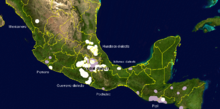Nahuatl dialectology
The Nahuan or Aztecan languages are those languages of the Uto-Aztecan language family that have undergone a sound change, known as Whorf's Law, that changed an original *t to /tɬ/ before *a. Subsequently, some Nahuan languages have changed this /tɬ/ to /l/ or back to /t/, but it can still be seen that the language went through a /tɬ/ stage. The best known Nahuan language is Nahuatl.
Some authorities, such as the Mexican government, Ethnologue, and Glottolog, consider the varieties of modern Nahuatl to be distinct languages, because they are often mutually unintelligible and their speakers have distinct ethnic identities. As of 2008, the Mexican government recognizes thirty varieties that are spoken in Mexico as languages (see the list below).
Researchers distinguish between several dialect areas that each have a number of shared features: One classification scheme distinguishes innovative central dialects, spoken around Mexico City, from conservative peripheral ones spoken north, south and east of the central area, while another scheme distinguishes a basic split between western and eastern dialects. Nahuan languages include not just varieties known as Nahuatl, but also Pipil and the extinct Pochutec language. The distinction between the Nahuatl and Pochutec is now thought to be due to language contact; see Pochutec language for details.
The differences among the varieties of Nahuatl are not trivial, and in many cases result in low or no mutual intelligibility: people who speak one variety cannot understand or be understood by those from another. Thus, by that criterion, they could be considered different languages. The ISO divisions referenced below respond to intelligibility more than to historical or reconstructional considerations. Like the higher-level groupings, they also are not self-evident and are subject to considerable controversy.
...
Wikipedia

